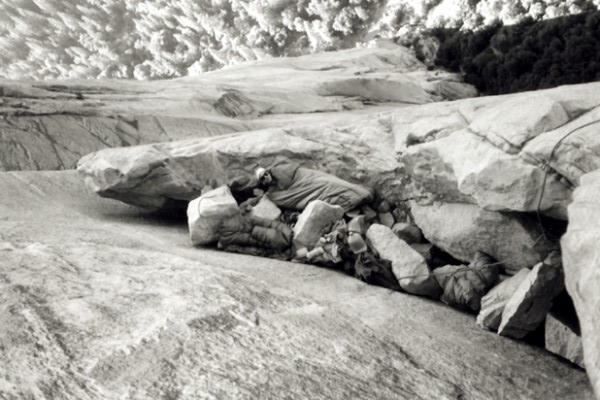Salathé Wall (El Capitan) on:
[Wikipedia]
[Google]
[Amazon]
The ''Salathé Wall'' is one of the original
 The
The
Supertopo.comMountainproject.com
{{DEFAULTSORT:Salathe Wall (El Capitan) Big wall climbing routes Yosemite National Park
big wall climbing
Big wall climbing is a form of rock climbing that takes place on long and sheer multi-pitch climbing, multi-pitch climbing routes, routes (of ''at least'' 6–10 pitches or 300–500 metres) that require a full day, if not several days, to ascen ...
routes up El Capitan
El Capitan (; ) is a vertical Rock formations in the United States, rock formation in Yosemite National Park, on the north side of Yosemite Valley, near its western end. The El Capitan Granite, granite monolith is about from base to summit alo ...
, a high granite
Granite ( ) is a coarse-grained (phanerite, phaneritic) intrusive rock, intrusive igneous rock composed mostly of quartz, alkali feldspar, and plagioclase. It forms from magma with a high content of silica and alkali metal oxides that slowly coo ...
monolith in Yosemite National Park
Yosemite National Park ( ) is a List of national parks of the United States, national park of the United States in California. It is bordered on the southeast by Sierra National Forest and on the northwest by Stanislaus National Forest. The p ...
. The ''Salathé Wall'' was named by Yvon Chouinard
Yvon Chouinard (born November 9, 1938) is an American rock climber, environmentalist, and businessman. His company, Patagonia, sells outdoor products, outerwear, and food. He was named one of the 100 most influential people in the world by '' ...
in honor of John Salathé, a pioneer of rock climbing in Yosemite. The route is recognized in the historic climbing text '' Fifty Classic Climbs of North America'' and is considered a classic around the world.
Climbing history
First ascents
 The
The first ascent
In mountaineering and climbing, a first ascent (abbreviated to FA in climbing guidebook, guide books), is the first successful documented climb to the top of a mountain or the top of a particular climbing route. Early 20th-century mountaineers a ...
was in 1961 by Royal Robbins, Tom Frost, and Chuck Pratt. After climbing about a quarter of the route, they retreated to re-supply, leaving four fixed ropes in place. Quickly returning, they jumared back up the ropes and totally committed to climbing the upper wall in a single push, which they did in 6 days using only 15 bolts total. The route was about 25% free climbing with sections of run-out at grade 5.9, and the rest being aid climbing
Aid climbing is a form of rock climbing that uses mechanical devices and equipment, such as aiders (or ladders), for upward momentum. Aid climbing is contrasted with free climbing (in both its traditional or sport free climbing formats), whi ...
which was also difficult at grade A4. A year later, Robbins and Frost returned and did the route in a single push from the bottom.
In 1972, Peter Haan became the first to aid climb the route alone as a rope solo, using pitons for aid and protection. It was his first big wall climb.
First free ascents
In 1975, Kevin Worral and Mike Graham, starting from the Nose route, traversed left a bit to join this route and free climbed pitches 4 through 10 of Salathe Wall Route up to Mammoth Terraces, adding three pitches of 5.11. A little later, John Long, and John Bachar free climbed pitch three (5.11b) making all 10 pitches free. These ten free pitches, often free climbed as a standalonemulti-pitch climbing
Multi-pitch climbing is a type of climbing that typically takes place on climbing routes, routes that are more than a single rope length (circa 50 to 70 metres) in height (or distance), and thus where the lead climber cannot complete the climb as ...
route in its own right, are known as ''Freeblast'' (5.11c).
In 1979, Mark Hudon and Max Jones, climbing from the ground up, led all but 250 feet of the route free, adding three pitches of 5.12 and 5 or 6 of 5.11.
In 1988, Todd Skinner and Paul Piana made the first free ascent
In mountaineering and climbing, a first ascent (abbreviated to FA in guide books), is the first successful documented climb to the top of a mountain or the top of a particular climbing route. Early 20th-century mountaineers and climbers focused ...
by free climbing all the sections (each climber free climbed only about half of the route, with 2 hanging belays for resting) during a nine-day push, after thirty days of working the route, and gave it a grade of 5.13c. The ''Salathe Wall'' was the first major route on El Capitan to be fully free climbed, and was the first-ever free ascent of a big wall route in history at the grade of .
In 1995, Alexander Huber
Alexander Huber (born 30 December 1968) is a German rock climber who is considered one of the greatest and most influential climbers in the history of rock climbing. Huber came to prominence in the early 1990s as the world's strongest sport c ...
became the first individual to free climb all the individual pitches, leading every pitch free himself in two pushes (with one hanging belay for a rest), and using an easier variation avoiding one of the cruxes, and assigned a grade of 5.13b.
In 2005, Steph Davis made the first female free ascent
In mountaineering and climbing, a first ascent (abbreviated to FA in guide books), is the first successful documented climb to the top of a mountain or the top of a particular climbing route. Early 20th-century mountaineers and climbers focused ...
, with the grade at 5.13b..
References
External links
Supertopo.com
{{DEFAULTSORT:Salathe Wall (El Capitan) Big wall climbing routes Yosemite National Park